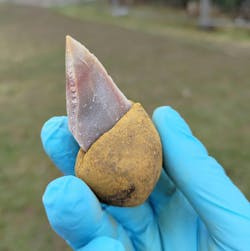Discovery: Using Compound Adhesives, Neanderthals Were Smarter Than We Thought
The oldest multi-component adhesive ever found in Europe is a sophisticated mixture of bitumen and ferric oxide-based earth clay ochre.
Today’s adhesives industry is massive, with technologies such as hot melts, reactive acrylics and UV systems driving their adoption to new heights.
This year alone, the market for adhesives is expected to reach nearly $100 billion. According to The Business Research Company, London, this will rise to over $130 billion by 2028 on the back of growing demand from the automobile, building and packaging industries.
It’s no surprise, therefore, that the list of manufacturers includes a large number from within the chemical industry.
Compound Adhesives Discovery
However, these are just the latest innovations in a long line of products whose first use could go back well over 200,000 years.
So far, the earliest use found of an adhesive-like substance was by Neanderthals who produced a tar from the dry distillation of birch bark.
Multicomponent adhesives are thought to have appeared 40,000-50,000 years ago, often used as handles for stone tools.
Now, a study carried out by researchers at the University of Tübingen in Germany and published in a recent issue of Science Advances has produced an in-depth analysis of what is thought to be the oldest multicomponent adhesive ever found in Europe: a sophisticated mixture of bitumen and the ferric oxide-based earth clay ochre.
Led by Patrick Schmidt from the university’s early prehistory and quaternary ecology section and Ewa Dutkiewicz from the Museum of Prehistory and Early History at the National Museums in Berlin, researchers re-examined finds from the over 40,000-year-old Neanderthal site of Le Moustier in the Dordogne, France.
Using analytical techniques including energy-dispersive x-ray spectroscopy, transmission infrared spectroscopy and gas chromatography/mass spectrometry, the researchers analyzed examples of a putative glue found on stone tools such as scrapers, flakes and blades.
They discovered traces of a mixture of ochre and bitumen on several of them.
“We were surprised that the ochre content was more than 50%. This is because air-dried bitumen can be used unaltered as an adhesive but loses its adhesive properties when such large proportions of ochre are added,” said Schmidt. He and his team investigated this in tensile tests and with experimentally produced reference material.
“It was different when we used liquid bitumen, which is not really suitable for gluing. If 55% ochre is added, a malleable mass is formed,” he shared. It is only just sticky enough for a stone tool to remain stuck in it, but the hands stay clean — so it is a good material for a handle.
A microscopic examination of the use-wear traces on these stone tools, carried out in collaboration with New York University, revealed the adhesives on the tools from Le Moustier were used in this way.
Use of adhesives with several components, including various sticky substances such as tree resins and ochre, was previously known from early modern humans, Homo sapiens, in Africa but not from European Neanderthals.
“Compound adhesives are considered to be among the first expressions of the modern cognitive processes that are still active today,” explained Schmidt.
In the Le Moustier region, ochre and bitumen had to be collected from distant locations, which meant a great deal of effort, planning and a targeted approach.
“Taking into account the overall context of the finds, we assume that this adhesive material was made by Neanderthals,” noted Dutkiewicz.
Adhesives Link Human Evolution
“What our study shows is that early Homo sapiens in Africa and Neanderthals in Europe had similar thought patterns,” said Schmidt. “Their adhesive technologies have the same significance for our understanding of human evolution.”
The idea that the adhesives were used as handles directly attached to stone tools rather than for hafting stone tools to handles lines up with behavior already known from the European Middle Paleolithic — up to about 10,000 years ago.
In their article, the team notes how important this work is for our understanding of the economy and technology of foragers during this period: “They invested time and effort in making compound adhesives and had the cognitive capacities needed. This technology provided new materials with specific and desirable material properties. This capacity and the willingness to invest in tools that represented an elevated cost documents the complexity of late Middle Paleolithic hominin behavior.”
The project, called Ancient Adhesives, runs until January 2025 with €1.5 million ($1.6 million) of funding provided by the European Research Council.
Its overall aim is to create the first reliable method to compare the complexity of Neanderthal and modern human technologies.
About the Author
Seán Ottewell
Editor-at-Large
Seán Crevan Ottewell is Chemical Processing's Editor-at-Large. Seán earned his bachelor's of science degree in biochemistry at the University of Warwick and his master's in radiation biochemistry at the University of London. He served as Science Officer with the UK Department of Environment’s Chernobyl Monitoring Unit’s Food Science Radiation Unit, London. His editorial background includes assistant editor, news editor and then editor of The Chemical Engineer, the Institution of Chemical Engineers’ twice monthly technical journal. Prior to joining Chemical Processing in 2012 he was editor of European Chemical Engineer, European Process Engineer, International Power Engineer, and European Laboratory Scientist, with Setform Limited, London.
He is based in East Mayo, Republic of Ireland, where he and his wife Suzi (a maths, biology and chemistry teacher) host guests from all over the world at their holiday cottage in East Mayo.


